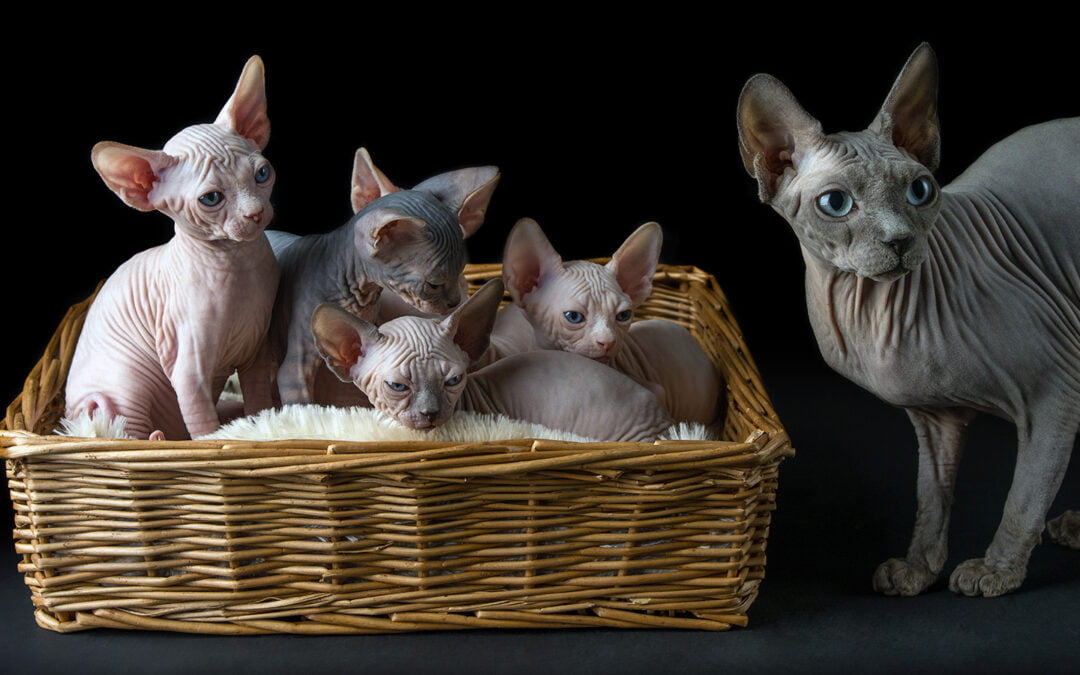Sphynx cats are those adorable, wide-eyed cats notable for their hairless bodies and beautiful big eyes.
Some interesting facts about sphinx cats:
- They are goofy felines who love to play and sometimes act more like dogs than cats
- Sphynx cats are originally from Canada (did you think they were from Egypt? I did!)
- They love to sunbathe and snuggle with their owners under blankets – no9surprise since without lots of furs they need to keep warm!
- Sphynx cats average 6-12 pounds in weight and live an average of 9 to 15 years.
- Coat colors are numerous, including but not limited to white, black, chocolate, and calico.
- The highly affectionate, high energy Sphynx is very playful and loves to “talk.”
- Originally called the Canadian hairless, the Sphynx is an increasingly popular pet in the U.S.
I hope you enjoyed those interesting facts about Sphynx cats – and now, onto their care!
Grooming is extremely important even though this breed has no real fur. Because they have no fur, they cannot absorb their body oils and require regular care to maintain a healthy balance of oil and prevent skin problems and oil spots on your furniture.
It’s important to bathe your sphinx cat at least once a week in order to remove oil build-up. You need to be sure to scrub in between their many wrinkles and folds as well.
Although sphinx cats look entirely hairless, they are actually covered in a very fine suede-like coat, which means they’re not 100% hypoallergenic, but physicians do recommend this breed to people who want a cat. If a person is only allergic to animal hair, but not dander or oil, the sphinx may be the perfect pet.
Because of their lack of hair, the sphinx is sensitive to sun exposure – they don’t have any protection from harmful UV rays. They should have only a limited amount of sun. These cats can get a sunburn just like us humans! These cats should be indoor pets only (which as you well know, I strongly advocate all housecats be indoor cats for their own safety.)
Sphynx Cats can be prone to hypertrophic cardiomyopathy, which is a common heart disease-causing heart muscle thickening.
They can also be prone to periodontal disease or gum disorders. In addition to weekly baths, tooth brushing is very effective to prevent these problems. You may be saying “OMG, how the heck can I brush my Sphynx’s teeth?”
Fear not dear readers, here is information on how to brush your cat’s teeth (and it doesn’t have to be a Sphynx to brush their teeth.)
How to Brush Your Cat’s Teeth
Going over the top of your cat’s head while standing behind the cat, gently stroke and massage your cat’s face. If he backs off and/or seems upset, STOP. You don’t want to be bitten or scratched.
Put a little cat toothpaste on your finger and see if your cat likes the toothpaste. If he does, hold your cat by putting your hand around her lower jaw and top of her head. Rub your cat’s teeth with your finger with a little toothpaste for a few days; then use a toothbrush (get one at your local pet shop) and brush gently – do this 2-3x a week.
I hope this information helps all my Sphynx loving readers! Feel free to leave your questions and comments below…I love hearing from you!


Recent Comments